A New Presidential Memorial Stamp Is Waiting in The Wings
By John M. Hotchner
[It’s been about a year since George H.W. Bush, the 41st president of the United States, died, and several months since the U.S. issued a stamp for him.]
 I had the good fortune to meet him—twice—and I’m a fan. So I looked forward to the commemorative memorial stamp for him that was issued on his next birthday, June 12, 2019.
I had the good fortune to meet him—twice—and I’m a fan. So I looked forward to the commemorative memorial stamp for him that was issued on his next birthday, June 12, 2019.
This is a tradition that has its roots in the 19th Century, with the issuance of the first presidential mourning stamp of the United States in April, 1866, a 15¢ stamp in black (Scott #77, plus later grilled issues) honoring Abraham Lincoln; who had been assassinated a year earlier. The earliest known use, per Scott, is April 21, 1866.
A mourning stamp was a novelty in 1866, though earlier presidents had been included in the stamp program after their passing. But Lincoln s e t a n e w standard: a stamp in black, issued within a year of death, or shortly after. A use of his stamp, on a mourning cover, is shown in Figure 1.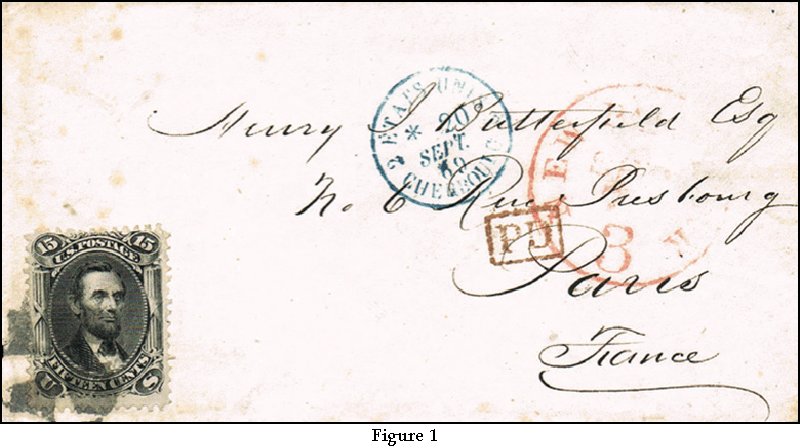
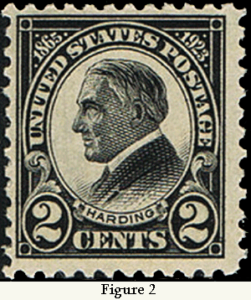 We would not see such an issuance again until the passing of Pres. Warren Harding from a heart attack on August 2, 1923. A mourning stamp in his honor (Figure 2)—a flat plate-printed, perf. 11 version (Scott #610)—was released just a month later, on Sept. 1, 1923. It was followed by three more versions (perf. 10 flat plate, imperf., and perf. 11 rotary press; Scott #s 611-613) within a couple of months.
We would not see such an issuance again until the passing of Pres. Warren Harding from a heart attack on August 2, 1923. A mourning stamp in his honor (Figure 2)—a flat plate-printed, perf. 11 version (Scott #610)—was released just a month later, on Sept. 1, 1923. It was followed by three more versions (perf. 10 flat plate, imperf., and perf. 11 rotary press; Scott #s 611-613) within a couple of months.
After this there was a hit-or-miss period. Woodrow Wilson, who passed away in 1924, after he left office, 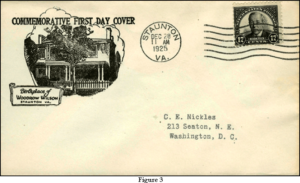 was given a 17¢ memorial stamp in black (Scott 623) almost two years after he died, seen in a first day cover, Figure 3. William Howard Taft whose presidency ended in 1913, left us on March 8, 1930, and was included in the Fourth Bureau issue with a brown 4¢ sheet stamp and a coil just three months later (Fig. 4)
was given a 17¢ memorial stamp in black (Scott 623) almost two years after he died, seen in a first day cover, Figure 3. William Howard Taft whose presidency ended in 1913, left us on March 8, 1930, and was included in the Fourth Bureau issue with a brown 4¢ sheet stamp and a coil just three months later (Fig. 4)
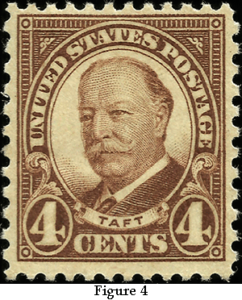 But Calvin Coolidge, who passed in 1933 was not placed on a stamp until the presidential issue of 1938, where he was the honoree on the $5 (Scott #834).
But Calvin Coolidge, who passed in 1933 was not placed on a stamp until the presidential issue of 1938, where he was the honoree on the $5 (Scott #834).
The next president to die was Franklin D. Roosevelt, on April 12, 1945; at the start of his fourth term. Four stamps were issued in his honor—none of them black—within a year of his death. The first was released on June 27, 1945; a 3¢ purple (which can be considered as a mourning color). It was followed by a 1¢ blue green, a 2¢ carmine rose, and a 5¢ bright blue (Scott #930-933). They broke the mold by including illustrations of more than just the picture of the president. See Figure 5 below.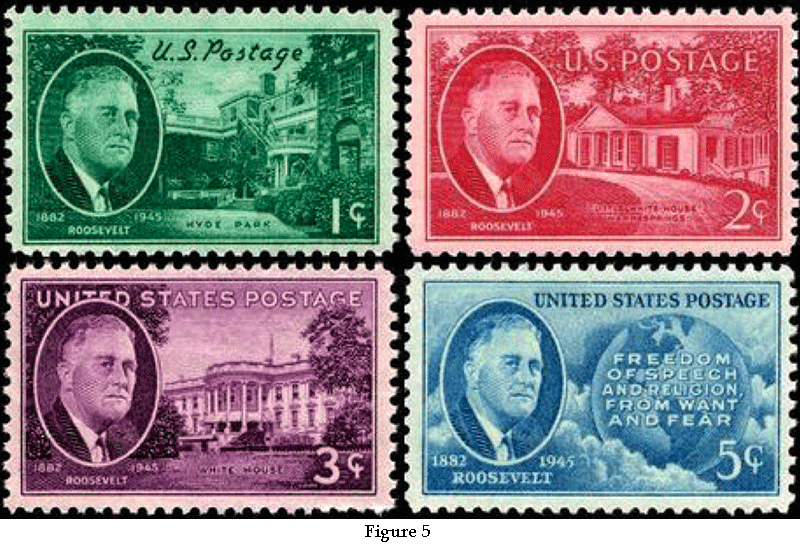
The next president to die was John F. Kennedy, the victim of an assassin, on November 22, 1963. And here is where the modern system of memorial stamps was inaugurated. On May 29, 1964, a 5¢ blue-grey commemorative was issued showing JFK and his eternal flame (Scott #1246, Figure 6). His birth date was May 29, 1917.
Figure 6 shows JFK on a Sc. 1246 FDC along with stamps for other assassinated Presidents: McKinley, Garfield, and Lincoln (Sc. 559, 558, 1036)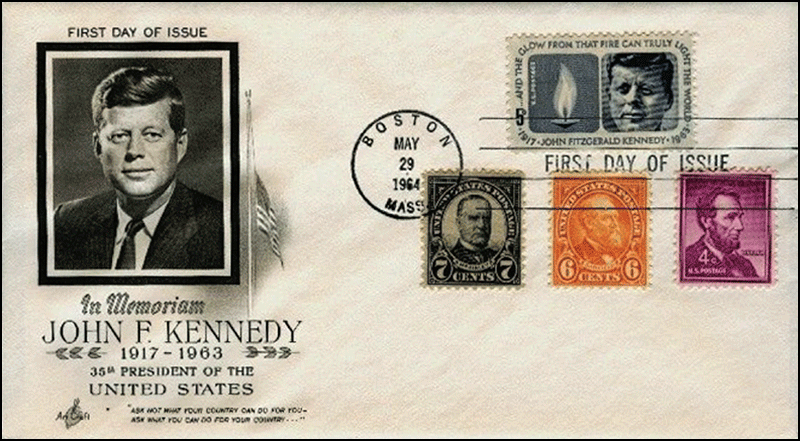
Presidential deaths after Kennedy, and the date of their memorial stamp (on or near their birthday), are shown here:
| Name Herbert Hoover Dwight D. Eisenhower Harry S. Truman Lyndon B. Johnson Richard Nixon Ronald Reagan Gerald Ford George H.W. Bush |
Date of Death Oct. 20, 1964 March 28, 1969 Dec. 26, 1972 Jan. 22, 1973 April 22, 1994 June 5, 2004 Dec. 26, 2006 Nov. 30, 2018 |
Date of Issue Aug. 10, 1965 Oct. 14, 1969 May 8, 1973 Aug. 27, 1973 April 26, 1995 Feb. 9, 2005 Aug. 31, 2007 June 12, 2019 |
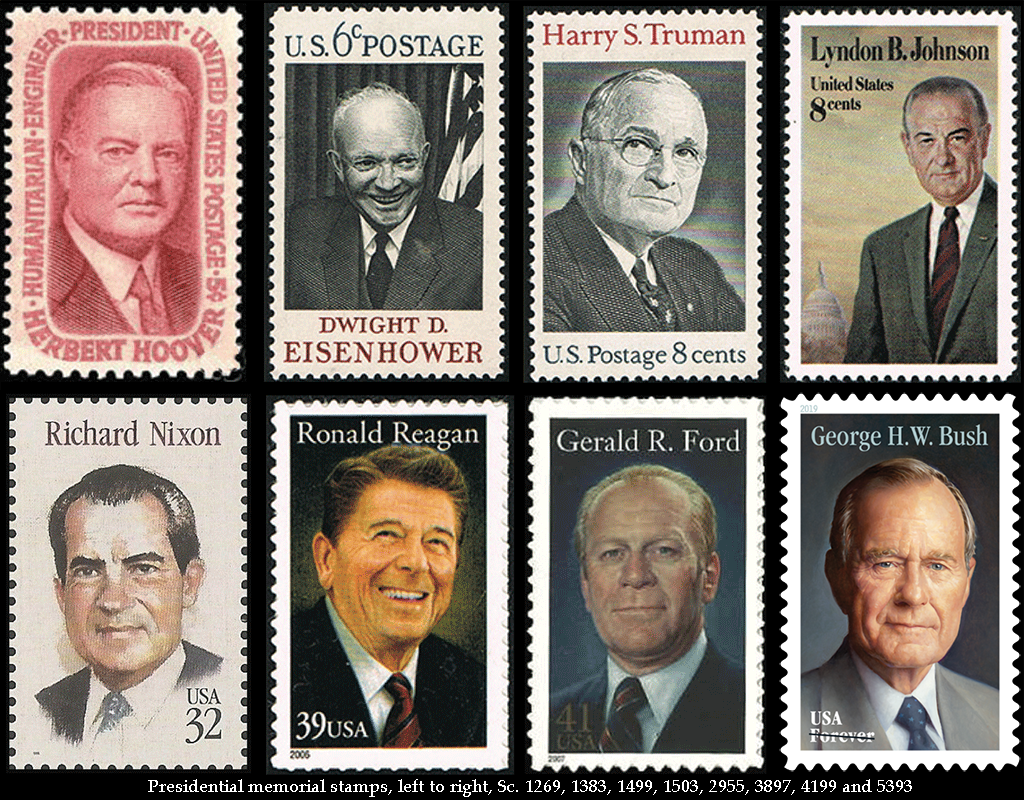 We are long past the times when the U.S. Postal Service was simply reactive to a presidential passing. Wouldn’t be prudent. They now have “in the bank” an approved image of each president who has left office, ready for use on the memorial stamp. It has been selected by the president himself, and discussed with the immediate family as well.
We are long past the times when the U.S. Postal Service was simply reactive to a presidential passing. Wouldn’t be prudent. They now have “in the bank” an approved image of each president who has left office, ready for use on the memorial stamp. It has been selected by the president himself, and discussed with the immediate family as well.
Also gone are the grim black stamps that celebrate death, in favor of brighter colorful portraits. This is not to say that all the presidential memorial stamps are beautiful—or popular. Richard Nixon’s stamp was not expected to do well, so the USPS ordered only 80 million printed. Compare that to the 511,750,000 stamps ordered for JFK, and 170 million for Ronald Reagan.
Should you wish to comment on this editorial, or have questions or ideas you would like to have explored in a future column, please write to John Hotchner, VSC Contributor, P.O. Box 1125, Falls Church, VA 22041-0125, or email, putting “VSC” in the subject line.
Or comment right here.




Let’s not forget that the Reagan stamp was issued twice. As you noted it was first issued as a 37c stamp on 2/9/05. It was then reissued at 39c on 6/15/06. I’m not sure if the 170 million includes both issues or not. I assume it was reissued after the rate change because it was still popular, or maybe because of politics, or both.
Why no mention of the William McKinley stamp (Scott 326), issued three years after his death?
Mourning stamps are generally thought to be those issued within a year of death. #336 recognizes McKinley as a historical figure, but as a commemorative within a commemorative set marking a different subject three years after his death, to me it does not have the same weight as a definitive timely issued, intended solely to honor the fallen president. That said, it could have been mentioned in the article. I just didn’t see it as quite fitting the theme. John Hotchner